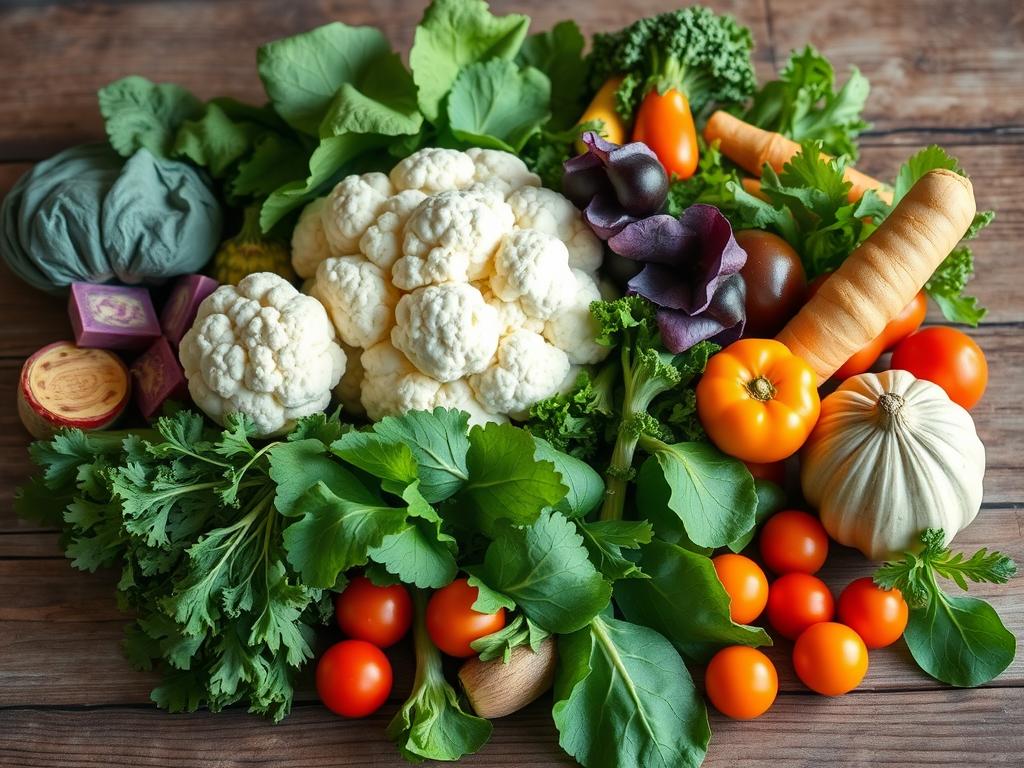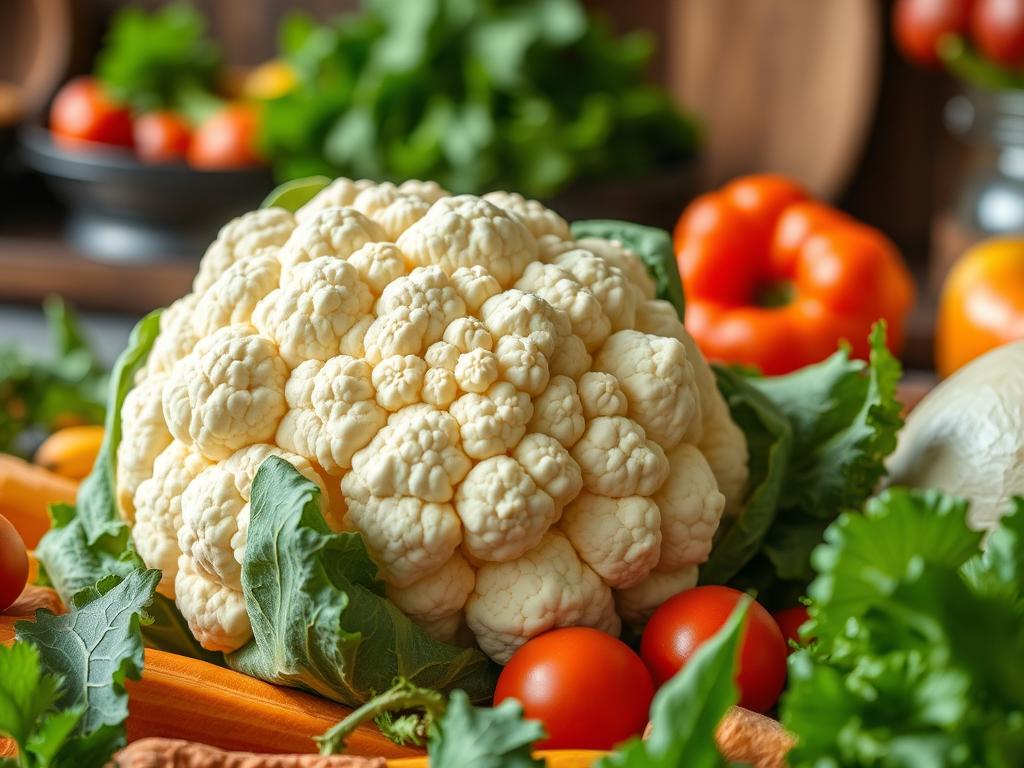Have you ever felt overwhelmed by the sheer number of food choices available? In a world filled with processed snacks and complicated diets, it can be challenging to find a healthy diet choice that not only meets your nutritional needs but also fits seamlessly into your lifestyle. When I first discovered cauliflower as a culinary staple, it was as though I had stumbled upon a hidden treasure. This modest, low calorie food is a powerhouse of nutrition and flavor, capable of transforming mundane meals into delightful experiences.
Cauliflower is part of the cruciferous vegetable family, alongside other favorites like broccoli and kale. It has garnered attention for its impressive list of health benefits, making it a truly high nutrient superfood. With only about 27 calories in one cup of raw chopped cauliflower, it’s a fantastic ally for anyone aiming for weight management without sacrificing taste or satisfaction. Join me as we explore the nutritional marvel that is cauliflower and uncover how to easily incorporate it into your diet. Together, we can embrace better health, one delicious bite at a time. For more inspiration on healthy eating, check out this article on avocados, another fantastic superfood.
Key Takeaways
- Cauliflower is a low calorie food, with only 27 calories per cup.
- This high nutrient superfood is rich in vitamins and minerals essential for health.
- Incorporating cauliflower into your diet can support weight management goals.
- Cauliflower offers more than half the daily recommended intake of vitamin C for adult women.
- This versatile vegetable can be prepared in numerous delicious ways to enhance any meal.
What Makes Cauliflower a Superfood?
Cauliflower stands out as a nutrient-dense option celebrated for its impressive range of health advantages. This versatile vegetable is not only low in calories but also rich in essential vitamins and minerals. A thorough understanding of its nutritional profile can highlight the superfood benefits of incorporating cauliflower into your diet.
Nutritional Profile Overview
One cup of cauliflower packs approximately 25 calories and is remarkably low in fat. It contains about 5 grams of carbohydrates, which is significantly lower compared to other staple foods. The impressive nutritional content includes:
- Vitamin C: 77% of the daily requirement
- Vitamin K: 20% of the daily requirement
- Vitamin B6 and Folate: 10% of the daily requirement each
Additionally, cauliflower is high in fiber, contributing to about 10% of daily fiber needs, making it an excellent choice for digestive health. Unique compounds such as sulforaphane, indoles, and glucosinolates enhance its health advantages, particularly in reducing inflammation and supporting overall wellness.
Health Benefits of Cauliflower
Incorporating cauliflower into your meals can yield various health benefits. Some of the notable advantages include:
- Improved digestion due to its high fiber content
- Support for heart health through essential nutrients
- Possible cancer-fighting properties attributed to unique antioxidants
- Cognitive benefits due to the presence of choline
Studies indicate that cauliflower’s composition may lower the risk of chronic diseases, contributing to overall well-being. Its rich array of vitamins and minerals further enhances its reputation as a superfood, making it an ideal addition to a balanced diet.
Low-Calorie Content: A Closer Look
Cauliflower is not only a versatile ingredient but also a prominent low calorie food that appeals to health-conscious individuals. With just 27 calories per cup, it serves as an excellent alternative to high-calorie options. Its low caloric density facilitates effective calorie comparison with other common vegetables and grains, reinforcing cauliflower’s role as a staple in healthy eating.
Caloric Comparison with Other Vegetables
The impressive nutritional profile of cauliflower highlights its superiority among various vegetables. Below is a comparative analysis showcasing its caloric content alongside other popular choices:
| Vegetable | Calories per Cup (Cooked) | Fiber (grams) |
|---|---|---|
| Cauliflower (Raw) | 27 | 2 |
| Cooked Rice | 242 | 1 |
| Broccoli (Raw) | 55 | 2.4 |
| Brussels Sprouts (Cooked) | 56 | 4 |
| Kale (Raw) | 33 | 2 |
As illustrated in the calorie comparison, cauliflower not only offers low calorie content, but its high water proportion (92% of its weight) enhances its satiating properties. This characteristic supports weight management by keeping you hydrated without excess calories. Moreover, its content of nutritious vegetables such as Vitamin C and fiber contributes positively to overall health and dietary balance.

Vitamins and Minerals Found in Cauliflower
Cauliflower is not just a low-calorie vegetable; it is a treasure trove of healthful nutrients. Packed with a variety of vitamins and essential minerals, this superfood contributes significantly to a balanced diet. Incorporating cauliflower into your meals can enhance your nutrient intake while pleasing your palate.
Key Vitamins in Cauliflower
This vibrant vegetable is particularly high in several important vitamins. Notably, one cup of raw, chopped cauliflower contains:
- Vitamin C: 51.6 mg, which supports the immune system.
- Vitamin K: 16.6 mcg, essential for bone health.
- Folate: 61 mcg, important for cellular function and tissue growth.
- Choline: 47.4 mg, necessary for metabolism and cognitive function.
Essential Minerals Present
The mineral content in cauliflower further elevates its status as a nutritional heavyweight. Each cup includes significant amounts of essential minerals, providing beneficial effects on overall health:
| Mineral | Amount per Cup |
|---|---|
| Calcium | 23.5 mg |
| Magnesium | 16 mg |
| Phosphorus | 47.1 mg |
| Potassium | 320 mg |
| Sodium | 32.1 mg |
Including cauliflower in your diet is an excellent way to obtain necessary vitamins in cauliflower as well as essential minerals that support various bodily functions, leading to improved overall health.
Antioxidant Properties of Cauliflower
Cauliflower stands out in the vegetable kingdom for its impressive antioxidant properties. Understanding these antioxidants sheds light on one of the many reasons this superfood boasts significant health benefits. The primary role of antioxidants is to protect the body from damage caused by free radicals, which can lead to various health issues.
Understanding Antioxidants
Antioxidants are compounds that neutralize free radicals, reducing oxidative stress in the body. These compounds can contribute to lowering the risk of chronic diseases such as cancer and heart disease. By including antioxidant-rich foods like cauliflower in your diet, you can enhance your overall well-being and support your body’s natural defenses.
Types of Antioxidants in Cauliflower
Cauliflower is abundant in several key antioxidants, including:
- Sulforaphane – Known for its potential to inhibit tumor growth in various cancers.
- Glucosinolates – Help detoxify the body and boost immune function.
- Isothiocyanates – Fight inflammation and may have anti-cancer properties.
- Flavonoids – Such as quercetin and kaempferol, which work in synergy with vitamin C for enhanced immune protection.
Incorporating a variety of cauliflower, including the vibrant purple variety rich in anthocyanins, maximizes these antioxidant benefits.
To experience these health benefits, consider adding this nutritious vegetable to your meals. One cup of raw cauliflower provides vast amounts of vitamin C, contributing approximately 77% of the daily recommended intake. You can explore more about the advantages of this amazing vegetable by checking out health benefits of cauliflower.

Incorporating Cauliflower into Your Diet
With its myriad benefits and mild flavor, cauliflower stands out as a versatile vegetable in many kitchens. There are endless cooking methods for this superfood that not only preserve its nutrients but also enhance its delicious taste. By experimenting with different techniques, home cooks can create satisfying meals that cater to a variety of dietary needs.
Delicious Cooking Methods
When preparing cauliflower, consider the following cooking methods to maximize flavor and nutrition:
- Steaming: Retains the most nutrients while providing a tender texture.
- Roasting: Adds a crispy exterior and enhances sweetness, making it a flavorful side dish.
- Sautéing: Allows for easy flavor infusion with herbs and spices.
Easy Recipes to Try
For those seeking easy cauliflower recipes, here are some popular dishes that make great use of this low-calorie vegetable:
- Cauliflower rice: A nutritious substitute for traditional rice, perfect for low-carb diets.
- Mashed cauliflower: A creamy alternative to mashed potatoes, offering similar comfort with fewer calories.
- Cauliflower pizza crust: An inventive way to enjoy pizza without the carbs, making it a hit for health-conscious eaters.
Incorporating these dishes into your meal planning can enrich your diet with essential vitamins and minerals while enjoying the delightful flavors of cauliflower. Embrace its versatility and make this nutritious vegetable a staple in your cooking! To further enhance your culinary skills, consider exploring more inspiring options, such as baked BBQ chicken drumsticks, which pair well with a side of roasted cauliflower.
Cauliflower and Weight Management
Cauliflower stands out as a weight loss friendly option, providing a wealth of benefits for those focused on effective weight management. With its impressive low-calorie content, this versatile vegetable is rapidly becoming a staple in many diets aimed at reducing calorie intake without sacrificing satisfaction.
Role of Cauliflower in Weight Loss
A cup of cauliflower contains only 25 calories, making it an ideal choice for low-calorie meals. Substituting heavier, high-calorie foods with cauliflower allows individuals to enjoy larger servings, which can significantly aid in weight loss efforts. The rich nutrient profile of cauliflower, offering 77% of the daily Vitamin C requirement, contributes to overall health while supporting weight management.
Satiety and Hunger Management
The high fiber content in cauliflower plays a crucial role in regulating appetite. Foods rich in fiber, like cauliflower, promote feelings of fullness, consequently reducing the likelihood of overeating. This combination of fiber and water makes cauliflower particularly effective for enhancing satiety, helping maintain a healthy diet. In addition, its low carbohydrate content supports those looking to manage weight while enjoying satisfying portions.

| Nutrient | Per Cup (Chopped, Raw) | Benefits for Weight Management |
|---|---|---|
| Calories | 25 | Low-calorie option for meals |
| Fiber | 2 grams | Promotes satiety and aids digestion |
| Vitamin C | 77% of Daily Value | Supports overall health |
| Protein | 2.1 grams | Helps in muscle maintenance |
| Carbohydrates | 5 grams | Low-carb alternative to high-calorie foods |
Popular Varieties of Cauliflower
Cauliflower comes in various delightful varieties, each offering unique tastes and nutritional benefits. While traditional white cauliflower remains the most widely recognized, colorful alternatives such as purple and orange cauliflower have gained popularity for their vibrant color and health-boosting properties.
Traditional White Cauliflower
White cauliflower is the classic variety that most people know. This variety is characterized by its creamy white florets and green leaves. Nutritionally, white cauliflower is low in calories, making it a staple in healthy diets. One cup provides only 25 calories while delivering essential nutrients, including Vitamin C and fiber. It serves as a versatile addition to a variety of dishes, from soups and salads to roasted vegetables.
Colorful Alternatives: Purple and Orange
Bright purple cauliflower stands out not only for its aesthetic appeal but also for its enhanced antioxidant content, particularly anthocyanins, which contribute to better health outcomes. Orange cauliflower, on the other hand, offers an impressive amount of beta-carotene, giving it its eye-catching hue. Both of these stunning cauliflower varieties retain the mild, nutty flavor common in all types of cauliflower, allowing them to be effortlessly incorporated into various recipes. Choosing colorful options adds not only visual interest to meals but also a boost in particular nutrients that can enhance overall health.
Environmental Impact and Sustainability
As more people become aware of their choices, the importance of sustainability in food production has gained significant attention. Growing cauliflower sustainably involves practices such as reducing pesticide use and encouraging organic farming. These methods not only enhance the health of the soil but also help to mitigate the overall environmental impact of agriculture. By incorporating sustainable agricultural methods — like crop rotation and reduced tillage — we can ensure that our food systems remain viable without depleting natural resources.
Growing Cauliflower Sustainably
Cauliflower is an excellent example of a crop that can thrive under sustainable farming techniques. As over 54 percent of Millennials adopt “flexitarian” diets, they contribute to minimizing their environmental footprints. Supporting sustainable cauliflower production helps to lower food-related emissions, contributing positively to climate change mitigation. Additionally, localized farming reduces transportation emissions, making it a crucial element in promoting a more eco-friendly food system.
Benefits of Choosing Local Produce
Choosing local produce, such as cauliflower, offers numerous benefits beyond taste and freshness. By supporting local farms, consumers can aid in reducing the transportation-related carbon emissions that result from long-distance food transport. With approximately one-third of all food produced worldwide facing waste, opting for locally sourced vegetables helps mitigate this issue by ensuring that food remains fresh and is consumed in a timely manner. Ultimately, making informed food choices not only supports healthier diets but also fosters community involvement and environmental stewardship.











